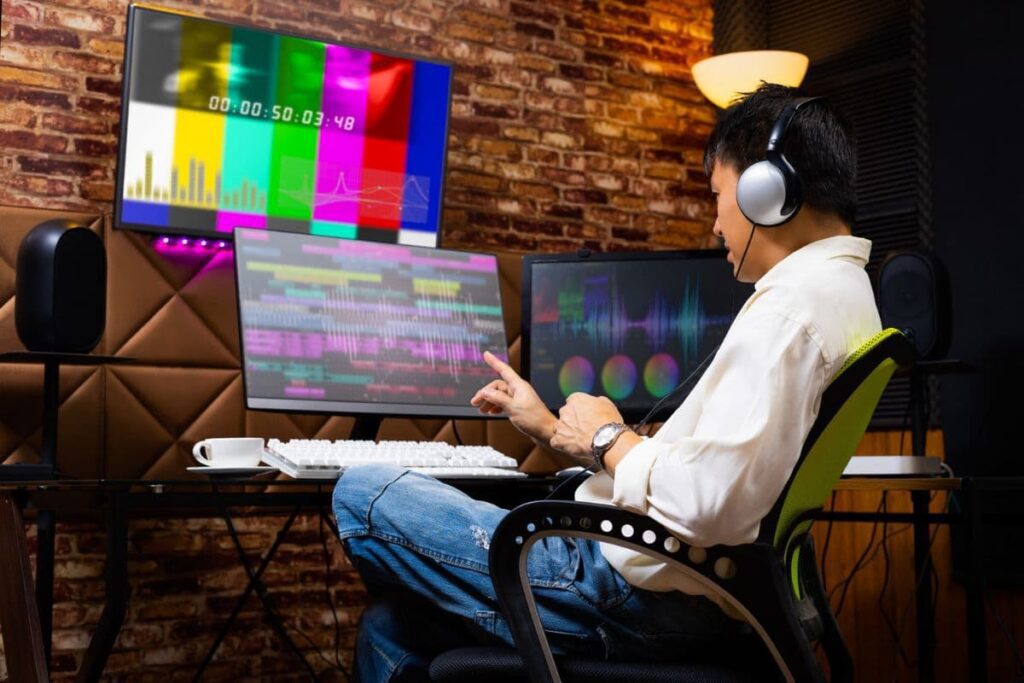Studio monitors are an integral part of any recording studio. Many musicians have them set up in their homes as well, allowing them to accurately mix and master their songs. However, because they are more powerful than most home speakers, some people worry that they use too much electricity.
Studio monitors don’t use much electricity. Research has shown that even running at seven or eight hours per day, studio monitors only cost you around $3 per month. Lights, air conditioning, and heat use significantly more energy than studio monitors.
Let’s dive into the details of how studio monitors work and why some people believe this product uses a lot of electricity.
Table of Contents
- Studio Monitors Don’t Use Much Electricity
- What Affects Energy Consumption in Studio Monitors?
- Studio Monitors vs Speakers: Power Consumption
- Wrapping It Up

Studio Monitors Don’t Use Much Electricity
There’s a myth that says that because studio monitors can output very loud sound, they use a lot of extra power. This same myth goes that if you leave these speakers on without using them, they’ll still be pulling significantly large amounts of energy.
The truth of the matter is that studio monitors, even when left on full-time, only use about 100 watts of energy per day. The price is minuscule when you compare this to your average air conditioning unit, which uses up to 3000 watts in a single hour.
In general, even keeping your house lit uses more energy than studio monitors.
What Affects Energy Consumption in Studio Monitors?
Studio monitors have three primary factors that affect how much energy is used at any given time.
- The Loudness of the Music
- The volume of the music
- The speaker sensitivity
The Loudness of the Music
Different types of music send out different audio levels. For example, rock is usually considerably louder than classical music.
How loud the audio signal determines how much current is pulled. If an audio signal is minimal, then the current being used will also be minimal and vice versa.
Other than the perceived loudness of a song, music with a lot of bass tends to pull more energy. This is because the speakers need more energy to produce sounds in the low end of the spectrum.
Of course, this factor is working together with the other two as well. It doesn’t mean that just because you’re playing classical instead of rock, you’re using less power.
The Volume of the Music
The next factor is the volume of the music. This is pretty simple—the louder you play your music, the more electricity is used.
Speakers produce sound by causing the air to vibrate with their drivers. These drivers move back and forth to create sound waves.
What determines the loudness of a sound is the amplitude of the wave. And in order to produce a wave with a higher amplitude, the driver will have to go through a larger displacement. As you can imagine, this increased movement leads to a slightly increased energy consumption.
As you raise the volume, the driver will have to produce stronger vibrations, and the amplifier, whether it’s external or inside your studio monitors, will need to pull more power to match the needs of the speakers.
The Speaker Sensitivity
Speaker sensitivity is defined by how many decibels a speaker can produce at a distance of one meter while using one watt of power. For every three decibels, the wattage doubles.
This means that the power being used adds up very quickly the higher the music volume goes. Sensitivity is measured in dB, and the higher it is, the less electricity it will need.
Let’s say we have two sets of studio monitors—one with 74dB of sensitivity and the other with 94dB— and we want them both to output music at 94dB. The studio monitors with low sensitivity will need 128 watts, while the studio monitors with high sensitivity will only need 16 watts.
However, this difference in efficiency becomes less noticeable as you reduce the volume. At low dB, both sets of monitors will use more or less the same amount of electricity.
Different speakers have different sensitivity levels. A speaker with a higher sensitivity level will use significantly less power than a speaker with a lower sensitivity level. Nowadays, many modern speakers are made with higher sensitivity levels.
Since any speaker will use a very low amount of electricity when compared to other electronic devices, sensitivity isn’t usually among the primary factors for choosing studio monitors. However, if you want to keep your bills at a minimum, you’ll still want to go for studio monitors with high sensitivity.
Studio Monitors vs Speakers: Power Consumption
It would be natural to think that studio monitors use more electricity than regular home speakers, given that they’re more accurate and often have more features. However, you’d be surprised to know that energy consumption is about the same for both devices.
Both speakers average about 100 watts in an hour, which, as discussed, doesn’t amount to that much. Even if you have your speakers on twenty-four hours a day, every day, you likely still wouldn’t be paying more than $6.00 per month for either device.
The energy consumption of both studio monitors and home speakers depends on the volume of the audio signal, the volume of the music, and the speaker sensitivity.
Overall, these two devices are really similar. The main differences between the two are that studio monitors output a better sound than regular speakers and often have internal amplification.
Studio monitors also have a more linear, flatter frequency response, which allows them to reproduce music as accurately as possible.
Meanwhile, home speakers often have a modified frequency response that usually accentuates bass and treble frequencies. This may produce a more exciting sound, but it’s not what musicians and audio engineers need when they’re making music.
Wrapping It Up
Studio monitors are great investments for any music professional. They’re used for mixing and mastering, producing, playing, recording, and much more.
Overall, studio monitors don’t use a lot of electricity, but the definition of “a lot” may vary from person to person. In any case, the benefit you’ll get from having studio monitors is well worth the monthly power consumption.
- Review of the ALABS IRON MINI-WL: A Powerhouse Wireless Microphone - October 4, 2023
- What is a Saturator in Music Production: A Brief Explanation - May 11, 2023
- What Are Rotary DJ Mixers? An Overview - May 11, 2023
SoundStudiomagic.com is a participant in the Amazon Services LLC Associates Program, an affiliate advertising program designed to provide a means for sites to earn advertising fees by advertising and linking to Amazon.com. We also participate in other affiliate programs which compensate us for referring traffic.

